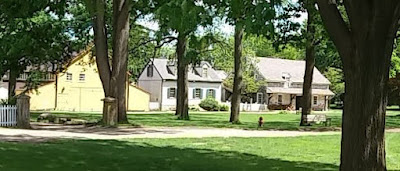 |
| From left: the Yellow Barn, Erisman House, and Tavern (photo from Landis Valley Village & Farm Museum Facebook page) |
[Editor's note: This is the second installment of a guest post by Keystone Intern Claire DeVinney. A junior at Millersville University majoring in Atlantic World Studies and minoring in Spanish, Claire spent her summer at Landis Valley Village & Farm Museum assisting curator Jennifer Royer with collections care and interpretation. In last week's post, Claire wrote about some research materials related to World War II. Today's post focuses on two exhibits she developed for the museum's Collections Gallery display windows. There is a separate page with additional photos from Claire's work this summer. Stay tuned at the bottom of this post for more info on Trails of History interns and a link to the list of events coming up in the week ahead.]
As an intern for the Pennsylvania Historical and Museum Commission, I have had the privilege of learning about the behind-the-scenes museum work at Landis Valley Village & Farm Museum. Like most museums, only a small percentage of Landis Valley's collection is on display. The rest of the artifacts are in one of Landis Valley's four storage buildings. With over 150,000 objects in the collection, some items are very rarely or never included in one of Landis Valley's rotating exhibits. [You can find many of PHMC's collections online via our website.]
 |
| View into the Collections Gallery before the shelves are filled (photo Claire DeVinney) |
Traditionally, it is the job of Landis Valley's interns to set up the collections gallery exhibit windows. I chose a theme for each of my two sets of shelves.
 |
| Three wooden cowboy carvings by artist Larkin Scull (photo Claire DeVinney) |
In the first exhibit window, I focused on the works of folk artist Larkin Scull (1892-1966). Scull grew up on a southeastern Pennsylvania farm, and much of the wood carvings he created reflect his familiarity with hunting and agriculture. Many of his works depict livestock or people completing agricultural chores. His works also reflect the popular culture of the 1940s and 1950s. Scull created carvings of cowboys, horse racing, boxing, two statuesque depictions of George Washington, and a stunning five-and-half-foot long Anheuser-Busch Budweiser wagon complete with eight Clydesdales.
Because Scull carved figures from his own world of southeastern Pennsylvania, his body of work is like a time capsule of the period when Landis Valley's founders, Henry and George Landis, were collecting artifacts to preserve the Pennsylvania German agricultural way of life.
 |
| Horse and cattle powder containers from the Newcomer veterinary collection (photo Claire DeVinney) |
The second exhibit window features items from the veterinary office of Dr. Ezra Newcomer, from nearby Mount Joy, Pennsylvania. Before Dr. Newcomer passed away in 1960, he was Lancaster County's oldest veterinarian. He earned his degree in veterinary medicine from the University of Pennsylvania in 1899. While sorting through the tools and items from his office, I came across his diploma and his Pennsylvania Veterinary Medical Association membership plaque. Identifying some of Dr. Newcomer's medical tools was a lesson in veterinary technology. Some of his implements, like a scale or tattoo pliers, were instantly recognizable, and look virtually identical to a tool a veterinarian might use today.
Other tools required a lot of research to identify--luckily, the collection included some of Dr. Newcomer's notes that I could consult for research assistance. I included a mixture of familiar and unfamiliar tools in the exhibit window to give visitors a sense of how veterinary medicine is different now than it was in the early 20th century and how it is the same.
Learning more about artifacts like these has made me more interested in history and more grateful for my experiences as an intern at Landis Valley. The opportunities I have had this summer have been rewarding and educational and have strengthened my appreciation for the institutions that preserve the past.
[I want to thank Claire and all of our PHMC summer interns for their hard work and wish them well in whatever lies ahead. Read about other intern projects and activities:
- Lydia Peifer, also at Landis Valley, organized a case exhibit on games
- Victoria Abramczuk worked with site administrator Mike Emery to record a presentation on her research into enslaved workers at Cornwall Iron Furnace
- PA State Historic Preservation Office intern Jacob Hockenberry blogged about his work with the PA Agricultural History Project and Sarah Hoffeditz wrote about the Mapping, Assistance, Resources, and Survey (MARS) project that took her to five Trails of History sites
- Abigail Sholes, Keystone intern at the Railroad Museum of PA, was featured in a post about the Public Heritage Studies program at Elizabethtown College
- Numerous Facebook posts welcomed or bid farewell to site interns and celebrated National Intern Day at Anthracite Heritage Museum and Eckley Miners' Village, Bushy Run Battlefield, Drake Well Museum & Park, Ephrata Cloister, The State Museum of PA



0 comments:
Post a Comment